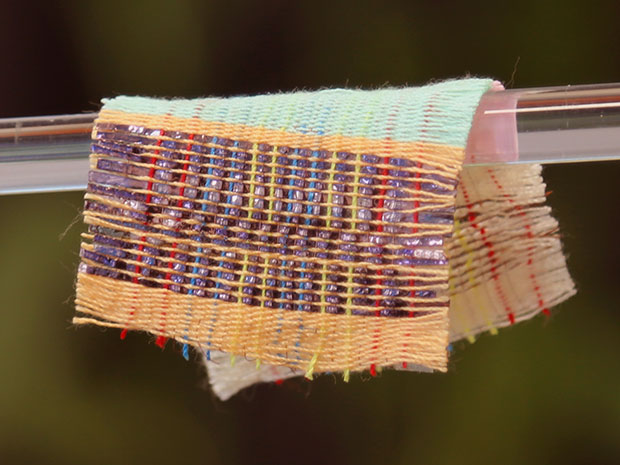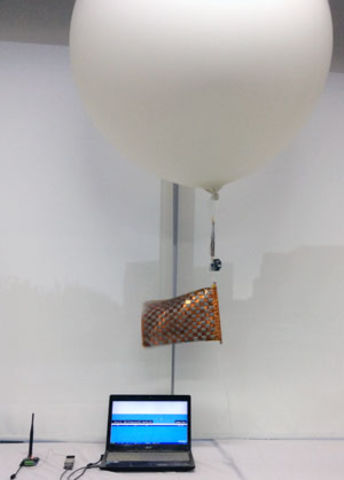Hybrid fabric converts sunlight and mechanical energy into electricity.

A joint team of scientists from the Georgia Institute of Technology (USA) and Chongqing University (China) has developed a new type of woven material that can generate energy by converting sunlight and wind energy into electricity. This fabric is woven of photosensitive material fibers, lightweight copper electrodes and polymer fibers, which produce electricity due to the triboelectric effect. Thus, this fabric is able to convert mechanical energy into electricity.
The thickness of the hybrid material is only 0.32 millimeter. It is lightweight, flexible, breathable. According to the developers, the main components are inexpensive. Such a fabric can be a part of clothing items, inserts from it can be used in the manufacture of tents or curtains, curtains, turning it all into a source of electricity. The novelty is almost a universal source of energy, because it can work day and night.

')
“We present material that can be used to generate energy,” said representative of the Georgia Institute of Technology Tzong Lin Wang. "The basis of this material is lightweight and inexpensive polymer fibers, so that the fabric we create can be used to create energy modules." This is not about power plants, but about inserts of such textile products into ordinary fabric.
The performance of the material is not too great, but it is enough to supply energy to simple electronic devices. A piece of fabric measuring 5 * 4 cm gives 0.5 mW in sunny weather. In a minute, this piece of tissue charges a capacitor of 2 mF (voltage - about 2 V). According to the inventors, all this can be scaled. For example, it will not be difficult to create a piece of material measuring 20 * 30 cm with a corresponding increase in productivity.

"Our material has virtually no restrictions on the scope of use." You can produce electricity everywhere. It may even be a flag that constantly evolves in the wind and receives a large amount of solar energy. The material can work without the sun. For example, if you attach it to a car traveling on the highway, then electricity will be generated by the triboelectric effect.
The triboelectric effect arises when metals and insulators come into contact due to friction, since no charges appear at the same time (or the resulting charge is negligible). The main result of friction is an increase in the area of actual contact, more frequent contacts of old surfaces and the formation of new ones.
Tourists, military, hunting and fishing lovers can be especially pleased with this energy source. The material can be folded and bent as you like. It still works well even after 500 folds. The production of electricity stops if the material gets wet, but if it is dried, the generation is resumed.
 For several years in a row, Tsong Ling Wang and colleagues have been working on the creation of a portable source of electricity, which is based on systems that convert mechanical energy into electrical energy. One of the prototypes of the current system was an energy-generating flag. He was hung on a balloon filled with helium. The wind was waving a flag, electricity was generated by friction. Such systems, according to the developers, can be used everywhere. The flag fabric fibers were very wide, as mentioned above, this is one of the first prototypes of this type of electricity generator.
For several years in a row, Tsong Ling Wang and colleagues have been working on the creation of a portable source of electricity, which is based on systems that convert mechanical energy into electrical energy. One of the prototypes of the current system was an energy-generating flag. He was hung on a balloon filled with helium. The wind was waving a flag, electricity was generated by friction. Such systems, according to the developers, can be used everywhere. The flag fabric fibers were very wide, as mentioned above, this is one of the first prototypes of this type of electricity generator.New fabric is much better, it is woven from fibers of much smaller size than in the case of the flag. To create it, the developers used an industrial loom. The resulting generator of electricity is compact in size and almost does not differ in appearance from ordinary fabric. At the same time, a small fragment of such material, fixed on the user's hand, is enough to simultaneously charge a mobile phone battery and a watch.
Another development of this team is biodegradable energy sources, which were supposed to be used in medical implants. As in other cases, here experts used triboelectric effect.
Source: https://habr.com/ru/post/397571/
All Articles